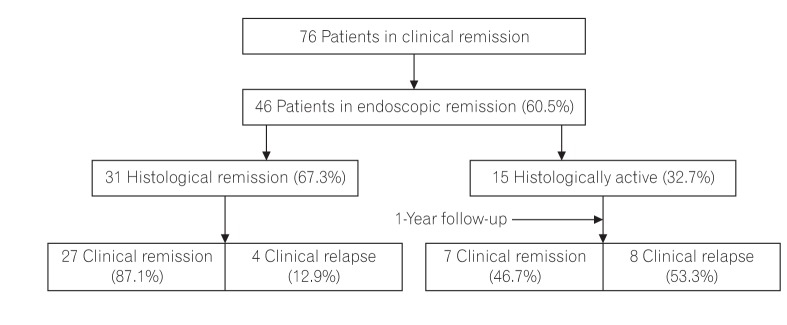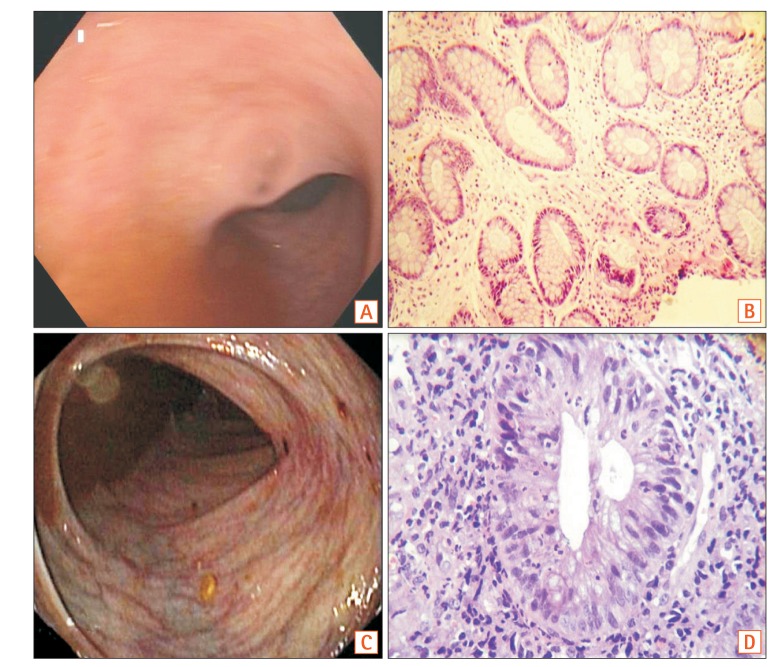Association of endoscopic and histological remission with clinical course in patients of ulcerative colitis
- Affiliations
-
- 1Department of Pathology, Dayanand Medical College and Hospital, Ludhiana, India. drvikramnarang@yahoo.com
- 2Department of Gastroentrology, Dayanand Medical College and Hospital, Ludhiana, India.
- 3Department of Internal Medicine, Dayanand Medical College and Hospital, Ludhiana, India.
- KMID: 2402647
- DOI: http://doi.org/10.5217/ir.2018.16.1.55
Abstract
- BACKGROUND/AIMS
The therapeutic goal for treating ulcerative colitis (UC) patients has shifted to achieving mucosal healing over the past few years. However, at present, limited data is available on the correlation between endoscopic findings and histological remission in patients with endoscopic mucosal healing.
METHODS
This was a prospective observational study conducted over a period of 18 months (January 2014 to June 2015) at Dayanand Medical College and Hospital, Ludhiana, Punjab, India. Patients diagnosed with UC who had been in clinical remission (n=76) for at least 6 months were evaluated for endoscopic remission. Those in endoscopic remission (Mayo score ≤1; 46/76, 60.5%) were subjected to multiple biopsies from the rectosigmoid region and histological remission, which was then defined as grade 0/1 as per the Geboes criteria.
RESULTS
Of the 46 patients in endoscopic remission (age, 18-73 years; male:female=1.5:1.0), majority had E1 (proctitis) disease (21/46, 45.6%) followed by E2 (left sided colitis) (18/46, 39.1%) and E3 disease (pancolitis) (7/46, 15.2%) at baseline. Histological remission was noted in 67.3% (31/46) of the patients, while 32.7% (15/46) still retained the histologically active disease in the form of infiltration of the lamina propria by eosinophils and neutrophils (13/15, 86.6%), cryptitis (14/15, 93.3%), and crypt abscesses (8/15, 53.3%). On follow-up, after 1 year, 87.1% (27/31) of the patients who had been in histological remission remained clinically asymptomatic, while 12.9% (4/31) had relapsed. Among the 15 histologically active patients, 46.6% (7/15) remained in clinical remission, while 53.3% (8/15) had relapsed.
CONCLUSIONS
Histological remission, rather than endoscopic remission, predicts a sustained clinical remission and allows monitoring of therapy for the subsequent disease course in patients with UC.
MeSH Terms
Figure
Cited by 2 articles
-
Colitis and Crohn’s Foundation (India) consensus statements on use of 5-aminosalicylic acid in inflammatory bowel disease
Ajit Sood, Vineet Ahuja, Vandana Midha, Saroj Kant Sinha, C. Ganesh Pai, Saurabh Kedia, Varun Mehta, Sawan Bopanna, Philip Abraham, Rupa Banerjee, Shobna Bhatia, Karmabir Chakravartty, Sunil Dadhich, Devendra Desai, Manisha Dwivedi, Bhabhadev Goswami, Kirandeep Kaur, Rajeev Khosla, Ajay Kumar, Ramit Mahajan, S. P. Misra, Kiran Peddi, Shivaram Prasad Singh, Arshdeep Singh
Intest Res. 2020;18(4):355-378. doi: 10.5217/ir.2019.09176.Adequacy of sigmoidoscopy as compared to colonoscopy for assessment of disease activity in patients of ulcerative colitis: a prospective study
Sameet Tariq Patel, Anuraag Jena, Sanjay Chandnani, Shubham Jain, Pankaj Nawghare, Saurabh Bansal, Harsh Gandhi, Rishikesh Malokar, Jay Chudasama, Prasanta Debnath, Seemily Kahmei, Rima Kamat, Sangeeta Kini, Qais Q Contractor, Pravin M Rathi
Intest Res. 2024;22(3):310-318. doi: 10.5217/ir.2023.00174.
Reference
-
1. D'Haens G, Sandborn WJ, Feagan BG, et al. A review of activity indices and efficacy end points for clinical trials of medical therapy in adults with ulcerative colitis. Gastroenterology. 2007; 132:763–786. PMID: 17258735.2. Travis SP, Higgins PD, Orchard T, et al. Review article: defining remission in ulcerative colitis. Aliment Pharmacol Ther. 2011; 34:113–124. PMID: 21615435.
Article3. Geboes K, Riddell R, Ost A, Jensfelt B, Persson T, Löfberg R. A reproducible grading scale for histological assessment of inflammation in ulcerative colitis. Gut. 2000; 47:404–409. PMID: 10940279.
Article4. Bryant RV, Burger DC, Delo J, et al. Beyond endoscopic mucosal healing in UC: histological remission better predicts corticosteroid use and hospitalisation over 6 years of follow-up. Gut. 2016; 65:408–414. PMID: 25986946.
Article5. Riley SA, Mani V, Goodman MJ, Dutt S, Herd ME. Microscopic activity in ulcerative colitis: what does it mean? Gut. 1991; 32:174–178. PMID: 1864537.
Article6. Bitton A, Peppercorn MA, Antonioli DA, et al. Clinical, biological, and histologic parameters as predictors of relapse in ulcerative colitis. Gastroenterology. 2001; 120:13–20. PMID: 11208709.
Article7. Bessissow T, Lemmens B, Ferrante M, et al. Prognostic value of serologic and histologic markers on clinical relapse in ulcerative colitis patients with mucosal healing. Am J Gastroenterol. 2012; 107:1684–1692. PMID: 23147523.
Article8. Azad S, Sood N, Sood A. Biological and histological parameters as predictors of relapse in ulcerative colitis: a prospective study. Saudi J Gastroenterol. 2011; 17:194–198. PMID: 21546723.
Article9. Schoepfer AM, Beglinger C, Straumann A, Trummler M, Renzulli P, Seibold F. Ulcerative colitis: correlation of the Rachmilewitz endoscopic activity index with fecal calprotectin, clinical activity, C-reactive protein, and blood leukocytes. Inflamm Bowel Dis. 2009; 15:1851–1858. PMID: 19462421.
- Full Text Links
- Actions
-
Cited
- CITED
-
- Close
- Share
- Similar articles
-
- The evolving understanding of histology as an endpoint in ulcerative colitis
- Ustekinumab for anti-tumor necrosis factor refractory pediatric ulcerative colitis: a promising approach towards endoscopic healing
- Remission of Ulcerative Colitis after Appendectomy: A Case Report
- Can histologic remission be a better prognostic factor and therapeutic target beyond endoscopic mucosal healing in patients with ulcerative colitis?
- Predictors of histologic remission in patients with biologic-naïve, moderate-to-severe ulcerative colitis treated with first-line biologic agents and small-molecule drugs: a single-center, retrospective cohort study



